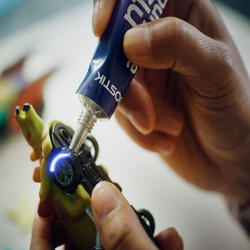Ideas and Inspiration
Ready to get creative? Discover our all our inspiration and DIY projects. From funky craft creations to recyclable projects we've got all the tutorials you need to unleash your creative potential.&nb…
How to
Welcome to our DIY How-To page! Here, you'll find a comprehensive selection of videos showcasing our repair adhesives in action. These tutorials guide you through the best methods to use or remove ea…
What are glue dots and what are they used for?
Bostik Glu Dots are pressure-sensitive, double-sided, adhesive dots available in a removable or permanent formula.Our Glu Dots can stick to almost anything including paper, wood, plastic, foam, metal…
What are the recommended uses of Glu Dots?
Bostik Glu Dots Removable are ideal for arts & craft, scrapbooking, card marking, collages and model making. Bostik Glu Dots Removable are the perfect size to allow for precise and accurate…
What is the shelf life of Glu Dots?
24 months, unopened, from date of manufacture. Store in dry conditions between +5⁰ C and +25⁰ C.
What is the difference between a multipurpose glue and super glue?
The main difference between a multipurpose glue and a super glue is the drying time. A super glue bonds within seconds (almost instantly) and an all purpose adhesive bonds within minutes (typically…
Do I need a super glue gel or a super glue liquid?
A super glue liquid has a low viscosity, meaning the liquid flows easily. This type of formula is great for filling horizontal surface cracks and fractures where the adhesive can flow into the cracks…
Does super glue work in the cold?
Yes, all Bostik super glues remain highly effective providing a strong, long-lasting bond in the cold, including temperatures as low as -20°C.
Is super glue flammable?
All Bostik super glues are non-flammable meaning they do not readily catch fire and do not burn easily.
Is super glue heat resistant?
Yes, all Bostik super glues are heat resistant up to +80°C.Safety warning: Persistent heat may affect the strength and longevity of the bond and therefore should be avoided.










